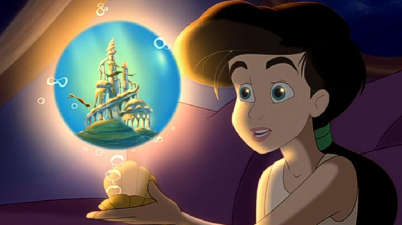My household came away from Cyber Monday with a discounted year’s subscription to Disney+, and, for no apparent reason, the first thing I actually watched on it was The Little Mermaid 2. Disney direct-to-video sequels are the poor, Plain Jane cousins to the Disney feature films; their lower budgets mean their songs are often lacking and their animation is subtly off. Voice actors aren’t always shown to their best advantage when restricted to doing imitations of their more famous predecessors. You’d love to say that at least the Disney sequels have a great personality. There has to be something in their favor.
To me, as a kid, there was. Even then, I knew the sequels were disposable in a way that the richer, better-crafted originals weren’t. But there was a scrappy charm to the direct-to-video offspring, and part of that comes from them being, perhaps, more squarely aimed at children. Parents need to be willing to sit through The Little Mermaid in theaters, but they could leave the kid alone with the VCR to watch The Little Mermaid 2. Adult investment wasn’t necessary in the same way.
I once had a huge soft spot for The Little Mermaid 2, if only because Ariel’s daughter, Melody, is a human girl who longs to be a mermaid, and that seemed to me to make way more sense than a mermaid wanting to be a human. I remembered exactly two scenes of the film before rewatching it: Melody exhilarating in the feel of her new mermaid body, ecstatic with the freedom it offers her in the ocean she’s always loved, and the sea wall around the castle coming down, allowing merfolk and humans to freely mingle once more. The Little Mermaid is a beautiful film; The Little Mermaid 2 is half “parents are unfair” and half “wouldn’t it be cool to be a mermaid?” I’ve already forgotten the song Melody sings when she’s racing through the ocean with her newly acquired body. As an adult, the resonance just isn’t there. But to a kid, the sugar, free of substance, was enough.
The other sequels I liked were The Return of Jafar (which I would still defend simply for the pleasant surprise of an Iago-the-parrot redemption arc and a handful of actually memorable songs) and The Lion King II: Simba’s Pride (which at least has a few memorable supporting characters and a charmingly angst-ridden forbidden love plotline). I haven’t rewatched them yet, but I doubt I’ll come away championing them as lost masterpieces. I would like them to reward a new viewing, ideally, but that’s all; and even if they don’t, I’m still grateful for the fond memories. They’re a handful of movies it would have been easy to miss, but they managed to mean something to me.
But all this at least made me think about what direct-to-video–or now, direct-to-streaming–movies can offer that theatrical releases don’t, whether that’s a shift in target audience (from family entertainment to kid entertainment) to fan-only prospects (there was a Cruel Intentions 2?) to more controversial material, more challenging themes, and more independent projects. The horror genre has benefited from the practice, certainly, with cult favorites like Trick ‘r Treat arguably falling under this umbrella. And if cut-rate sequels ruled the market for a long time, the new respectability of direct-to-streaming features means the delivery method is now a lot more diversified.
What are you seeing? What do you want to see? What are some of your old favorites from this kicked-around segment of cinema? And when should filmmakers aim for this kind of release over a theatrical one?

